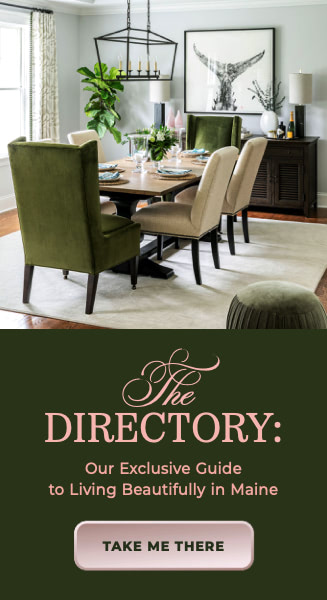I write from Rome, where I’m looking out my open window at a drone hovering three feet away. I rise from my desk and go to the window—what do you say to a strange drone? Then it’s gone, moving up and down the seven floors of my sixteenth century palazzo, now divided into ten condominiums.
Drones require a permit in the center of Rome because they could damage the historic ruins and churches. So I ask my neighbor if he knows what’s going on. “Tranquillo!” he says. They’re surveying the façade for the renovation.
This was good news. The stucco façade of our building is in bad shape, causing leaks around windows. It also looks terrible—appearances being everything in Italy, land of la bella figura. During Covid the city started a program to subsidize façade renewals, so naturally lots of building owners are jumping on overdue renovations.
That drone, and the façade work, got me thinking about traditions in domestic architecture in Maine—where I lived for twenty years and renovated two historic homes—as seen from the comfortable distance of a city where people have been putting up homes, and renovating them, for at least 3,000 years.
Every culture has its traditional building materials. In Rome that would be travertine, a type of limestone mined in the surrounding mountains for millennia, and kiln-fired bricks. Fortunately for historians, stone and brick last a long time. Modern Romans have been known to discover ancient Roman ruins during home renovations. The law says you need to stop work immediately and call the cultural authorities, but almost no one does because that would mean your renovation could be delayed… forever? The mind boggles at the Roman treasures hiding in renovated guest bedrooms across the city. Italians call this furbo—cleverness, which is a Roman tradition as old as travertine aqueducts.
The traditional building material of Maine is, of course, wood, for the very good reason that there is, or was, so much of it. England’s colonization of North America was in large part driven by New England’s virgin forests; the tallest trees in Maine were branded with King George’s symbol and cut down for ship masts.
Those primeval forests are now gone—yet Mainers, and most Americans, continue to build homes with dead trees. Given that wood is slow-growing, expensive, and (as always) subject to rot and infestation, this would seem ill-advised. But traditions die hard.
Don’t get me wrong: wood can be an honest element in historic colonial siding or vernacular Shingle-style homes. Over twenty years, I personally replaced the cedar siding on two antique midcoast homes, and, not being a fan of ladders, painted them more times than I care to recall. (Sadly no house-painting drone.) But mostly wood is an evolutionary relic, like the vestigial human tailbone or the wings on a flightless female cockroach.
Proof that we’ve evolved beyond the need for wood is the development of modern non-wood siding substitutes, like the dreaded vinyl (which always looks fake) and the much better cement board (which can’t be distinguished from wood after painting).
Under the skin, we now have metal studs instead of dead-tree studs, but most home builders despise them and they are generally left to commercial construction. Carpenters like wood. Even most brick homes in America (as well as contemporary and Mediterranean styles) have wooden frames underneath.
And so wood has not worn out its welcome, despite new and better building technology. The puzzle, from a European perspective, is why Americans still cling to wooden vernacular styles even in new construction. Why put colonial clapboard siding on a split-level ranch, which is a contemporary design meant to suit modern lifestyles? It’s like a bald guy with a comb-over: nobody is fooled. For that matter, why sheathe mobile homes in cheesy vinyl “clapboards?” There is nothing shameful about living in what is basically a box: across Germany you can find cheap housing made from stacked shipping containers. They range from rusty to brightly painted, and often include glass curtain walls and internal garden courtyards. They’re seriously cool. But mostly, they’re honest.
Another stubborn holdover from colonial times is the double-hung window, which can only be opened halfway. Back in the actual colonial era, when precious window glass was blown and spun by hand, panes were limited in size—hence muntin windows with all those tiny panes. We don’t need to do that anymore; unless you are restoring a historic home, why not use casement windows that open fully, allowing more natural ventilation? Yet people still build new “colonial” homes with snap-in plastic window muntins.
Likewise, those tacked-on plastic shutters you see on American homes everywhere–generally of a random size that has no bearing to the window dimension. I confess these drive me insane (but I also confess to mild OCD issues). Why on earth would you put fake shutters on your house? Just about every building in Italy, including my urban palazzo, has working shutters; they used to be made of wood but are now almost always maintenance-free metal. I close mine in the summer afternoon when the sun beats in; they have angled slats to allow ventilation even when shut. When I go away overnight, I close and lock them.
I could go all self-righteous and gloat that here in Italy we save wood for doors, and we build our homes with stone and brick and don’t tack on fake plastic stuff.
But the truth is more complicated.
Walk around the cobblestone streets of Rome and you become aware that some of the greatest masterpieces of Western architecture are faking it. Take those Baroque churches, whose domes define the Roman skyline. The ornate style was introduced by Giacomo della Porta, whose design featured a double-ordered façade crowned by a pediment buttressed by vast sweeping volutes.
But stroll around to the side of those churches and look up—often the pediment is a false front, like those Wild West saloons with a fake upper story, tacked on to convey more floors from the street than actually exist. I suspect the builders of Western pioneer towns stole the idea from Rome. You could be generous and call the Baroque style “theatrical.” Or you could call it… phony as a plastic shutter on a vinyl house.
You can find phonies across the canon of Western design, not least in those over-the-top French Gothic cathedrals. Possibly the last refuge of real was ancient Greece. The Parthenon pediments aren’t fake—they actually hold up the roof. Even the marble sculptures within the pediment (now in the British Museum, the Louvre, and the Acropolis Museum in Athens) were carved in full detail even on the back, where no one would ever see them. Why bother? No one would know. Because the sculptor would know, that’s why.
Those days are gone, but I think there are limits to acceptable fakery. If I still lived in Maine, I would build a house with insulated concrete forms and save the wood for doors. My Maine house would have working shutters to keep out the summer sun, the winter winds, and the occasional snooping drone.

